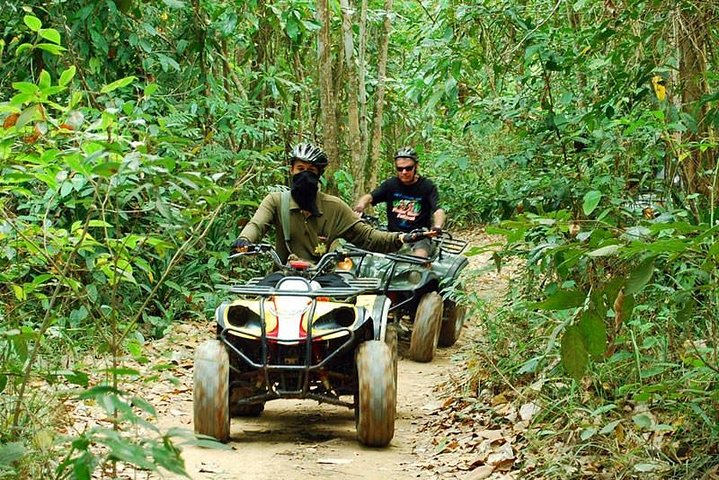Raft, Rev, Repeat: A One-Day Wild-Hearted Adventure from Phuket into Phang Nga’s Rainforest
Half river, half trail, all day—how to squeeze rafting and ATV thrills into one unforgettable day from Phuket.
The morning light over Phuket is the color of a promise: humid, soft, and restless. By 7 a.m. a van with Thai lettering and a driver who hums pop ballads carries a small, eager band of travelers north along Route 4. The road narrows, palms press closer, and the ocean recedes into a silver memory. You leave the tourist pins on the map—Patong, Karon—and enter a different geography where limestone hulks loom and the rainforest looms even larger. By midmorning, you’re standing on the bank of a narrow river; the current is whispering, then daring you, and a guide in a faded cap hands you a paddle with a grin that says: “You’re in for it.”
Trail Wisdom
Hydrate before you go
Drink water in the morning—the combination of sun, exertion, and salt spray dehydrates quickly.
Use a waterproof phone pouch
Mountains of spray and muddied trails mean your phone will thank you for protection; bring a lanyard.
Wear closed-toe shoes
ATV trails and riverbanks are rough; sturdy, quick-dry shoes prevent stubbed toes and blisters.
Listen to your guide
Guides call commands for safety—pay attention during the briefing and rapid sections.
Local Knowledge
Hidden Gems
- •Small roadside coconut-stall breakfasts in Phang Nga—fresh roti and kaya coffee
- •Quiet mangrove walk near Ko Yao Yai for birdwatching before or after your trip
Wildlife
Long-tailed macaque, Kingfisher
Conservation Note
Operators increasingly emphasize low-impact practices—stick to marked trails, avoid single-use plastics, and ask guides about local reef and river conservation efforts.
Phang Nga’s coastal shape and limestone formations have shaped local fishing and village life for centuries; Ko Yao Yai communities maintain longstanding Muslim fishing and rubber-tapping traditions.
Seasonal Guide
spring
Best for: warmer dry days, good river levels before monsoon, off-peak crowds
Challenges: heat and humidity, strong sun exposure
Spring (Mar–May) brings hotter temperatures—expect sweaty, intense days; mornings are best for activity.
summer
Best for: lush rainforest scenery, dramatic river flow, fewer tourists
Challenges: monsoon rains and slippery trails, possible cancellations
Summer overlaps with the monsoon (May–Oct): scenic and dramatic but subject to sudden storms and higher river flows.
fall
Best for: green landscapes after rains, cooling temperatures, improved river clarity
Challenges: residual muddy trails, variable weather windows
Fall (Sep–Nov) is transitional—vegetation is vivid and conditions gradually stabilize toward the dry season.
winter
Best for: cool dry weather, calmer rivers, ideal touring conditions
Challenges: slightly busier tourist season, earlier sunsets
Winter (Dec–Feb) is the preferred season—comfortable temps, stable weather, and clear days for river and trail.
Photographer's Notes
What to Bring
Quick-dry clothingEssential
Dries fast after rafting and is comfortable under a helmet for ATV sections.
Closed-toe trail shoesEssential
Protects feet on wet riverbanks and on the ATV—avoid flip-flops.
Waterproof phone pouch or small dry bagEssential
Keeps essentials and electronics safe from spray and mud.
Reusable water bottleEssential
Staying hydrated across warm tropical hours is critical; operators may provide water but carry your own.
Common Questions
How long is the rafting portion?
The advertised rafting segment is about 5 kilometers and typically lasts 45–90 minutes depending on water flow and stops.
Do I need prior rafting or ATV experience?
No—briefings are provided and guides lead the way; basic fitness and willingness to follow instructions are sufficient.
What is included in the tour price?
Most bookings include transfers from Phuket pickup points, safety gear (life vest, helmet), guides, rafting, and ATV rental; confirm specifics at booking.
Is the trip suitable for kids?
Families with older children (teens) will usually be fine; operators set age and weight limits for safety—check the provider’s policy.
What happens in heavy rain or high water?
Operators monitor conditions—sections may be modified or the tour canceled for safety; you’ll typically be offered rescheduling or refund options.
Can I bring my camera?
Yes—use a waterproof housing or pouch; consider leaving expensive DSLRs behind unless properly protected.
What to Pack
Quick-dry clothes (for comfort and fast drying); closed-toe shoes (protection on trail and riverbanks); waterproof phone pouch (protects electronics); reusable water bottle (stay hydrated in tropical heat)
Did You Know
Ko Yao Yai and nearby Phang Nga Bay host long-established Muslim fishing communities and traditional livelihoods—many locals still rely on fishing and rubber tapping.
Quick Travel Tips
Book morning departures to avoid afternoon storms; bring local cash for roadside snacks; confirm pickup point in advance if staying in Phuket; tip guides in local currency if service is good
Local Flavor
After your day, look for a beachfront seafood shack or small Phang Nga market stall for fresh grilled fish and som tam; in Phuket Old Town, try local southern curries and finished with a cold Leo beer to wind down.
Logistics Snapshot
Closest airport: Phuket International Airport (HKT) / Driving distance: ~80 km north of Phuket city (1.5–2 hours) / Cell service: generally good on roads, intermittent in rainforest and river valleys / Permits: no public permits typically required, but waivers and operator insurance are standard
Sustainability Note
Operators are gradually adopting low-impact practices—pack out trash, avoid reef-harming sunscreens, and ask about community benefits from tours to support local economies.

